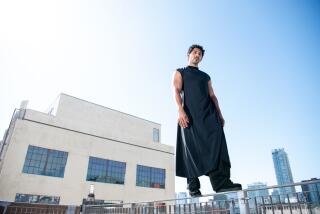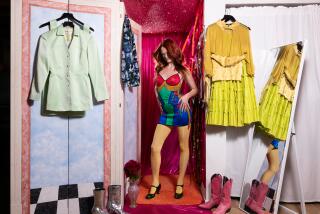Sitting down with Ian Callum, Jaguar’s style master
Jaguar’s design director, the Scottish-born Ian Callum, was in Los Angeles in late April to accept the BritWeek Design Icon award for his contributions to British design. BritWeek is an annual celebration of British contributions to architecture and style and is put on in collaboration with Architecture Digest.
Callum has been with Jaguar since 1999, and has been the driving force behind the company’s aesthetic reinvention that began with the 2008 XF midsize sedan. Prior to working at Jaguar, Callum designed the Aston Martin DB7 and DB9, cars whose designs are still largely seen on current Astons.
We caught up with Callum and his latest creation, the all-new F-Type, while he was in L.A. The two-seat F-Type convertible goes on sale later in May, with a coupe version all but certain to reach production in the near future. The car comes with a supercharged V-6 making either 340 horsepower or 380 horsepower or a supercharged V-8 making 495 horsepower.
PHOTOS: A closer look at Jaguar’s all-new F-Type convertible
The starting price on this rear-wheel-drive convertible with the base engine is $69,895, while a fully loaded V-8 model can top $100,000. Highway 1 will have a full review of the F-Type later in May.
In the meantime, read on to hear which cars on the road today are Callum’s favorites, hints about future Jaguar products, and his thoughts on being snubbed by Aston Martin.
Q: There are style elements on the F-Type, notably the taillights, that are similar to the C-X75 concept hybrid supercar from 2010. Do you save an element from a concept car that you particularly like for use on cars that will reach production?
A: Oh yeah, it’s all learning. Once you get something you like, there’s no point in throwing it away because the car didn’t happen. You’ve got to use it somewhere. I’ll be honest with you, this lamp we’ve come up with is very distinctive. You’ll see a little bit of this in the future, so it could become quite a signature for our Jaguar brand.
Q: What was the hardest part of bringing a design like the F-Type?
A: The most challenging part in terms of packaging the car was really the height of the hood. It’s for pedestrian regulations and the European [F-Types] we do have airbags under the hood. This surface here took about six or seven weeks of solid work. It was just millimeter by millimeter to get that as low as possible. It may seem a little trivial, but in actual fact, these things matter in a car like this.
Q: Which designs do you see on the road today that you admire?
A: I like the Audis still. I think the Audis, from a design point of view, are up there. I like the R8, I’ve always like the R8. I like mid-engined cars. But it’s difficult to tell, there’s not a lot of stuff out there that I’d rave about.
From a design point of view, I like simple cars like Volkswagens and things. They’re just nicely done; they’re beautifully done, they’re not Earth-shattering but these cars are very clean. I like that. In terms of American cars, I’m not really familiar with American cars on a daily basis.
Q: Historically, is there a golden era you admire?
A: Well, American cars, definitely the 1960s. I love that period, the Bill Mitchell period [a designer at GM for more than four decades who was responsible for cars like the 1957 Chevy Bel Air, the 1963 Corvette Stingray with the split back window, and the 1963 Buick Riviera], that was a wonderful time when cars were really works of art. GM was always better than Ford in terms of style in the 1960s and the ‘50s.
And also the Italian cars from the ‘60s and ‘70s were classic. I think they’ve kind of lost that now.
The new Ferrari, the 458, I think they’re tending towards beautiful cars again. I lost faith in them for a long time. I want to love Ferrari. I think Ferrari is just a brand that you naturally have to love.
Ferrari is not an Italian car, it’s a world car. People love it all over. So I think the new Ferraris are starting to show some promise.
I like Porsches. I do like them. I like the new 911, the 997 I like. The 996 I don’t, too fussy. My favorite is probably still a 993 in terms of size of the vehicle, the engine. That’s a personal thing. I nearly bought one. It was a classic car. A 993 would be a lovely classic, but they’re so damned expensive.
Q: What do you hope you’re best remembered for?
Everything, as long as people understood what I did. I did a pretty eclectic mix. I’ve been very fortunate to do many sports cars. It’s been quite a lot of fun. When I did the XF, I remember telling them that this is the first sedan car I’ve ever designed, but it’s worked out OK.
I’d like to be thought of as being really party to turning Aston around. And re-creating it in a way. Because they [Aston in the modern era] were nothing before the DB7. I think that recognition has been denied me a little bit, especially by the current regime. But that’s fine, I’m not overly sensitive about it.
But more than anything I’d like to be thought of as the person who actually turned Jaguar around and got it back to being great. That would be a lovely notion to leave the world with.
Q; In terms of turning Jaguar around, how far along would you say that process is?
A: I think there’s more to come.
Q: In terms of design?
No, I think the design is pretty well on stable footing now. It will never go retrograde again. I don’t see the need to make a massive realignment again.
But I think it won’t really be complete until not just the design is complete but the car lineup is complete, and we’ve been fairly open about that, that we are going to increase our car lineup. We have to. We have to become a big player. We’re just not big enough at the moment to have the gravitas on the average street, to have the recognition.
And therefore it’s self-perpetuating. If you’re not big enough, you’ll never grow, so you have to forcefully grow it. And we’re not small enough to be a niche player like Aston. Which will be nice. I foresee a bit more volume stuff coming. It has to happen.
Q: For both Jaguar and Land Rover?
A: Yeah. Land Rover is a much bigger brand anyway. But I can see a time when they’re on par in both volume and revenue. I’m sure some of my Land Rover colleagues might probably disagree with that, but that’s the ambition.
Q: In future products, [like Jaguar’s much-rumored compact sedan likely due in 2016] will they look like current Jaguar sedans or will they incorporate elements of the F-Type, like the taillight design, into them?
There’s hints of that in a lot of stuff we’re doing in the future. I think that’s a question we’ll have to wait and see the detail on. But to do a car like that, it’s important that we capture what we’ve already created. It’s not the right time to go and reinvent everything again. People would be very confused. What we have got to do is get people to understand that Jaguar is there. So [the look] I think is pretty well set for the next five years. You’ll recognize it.
ALSO:
Photos: Ford’s Atlas Concept truck rolls into L.A.
Review: Mazda6 injects fun and good looks into family sedan
Bill Ford: The future of self-driving cars is closer than you think







